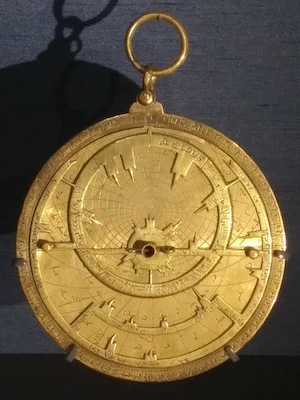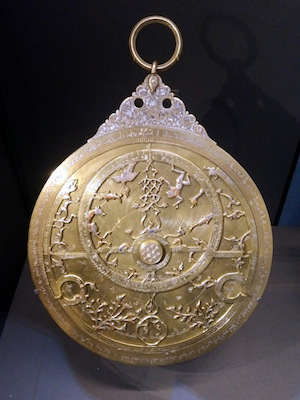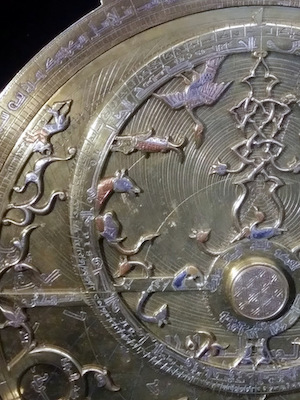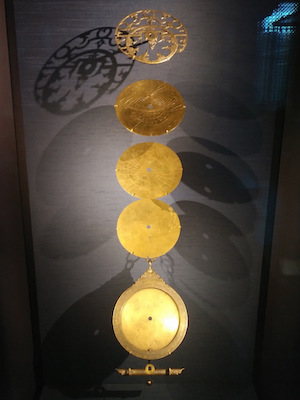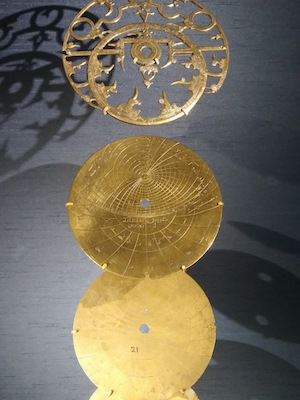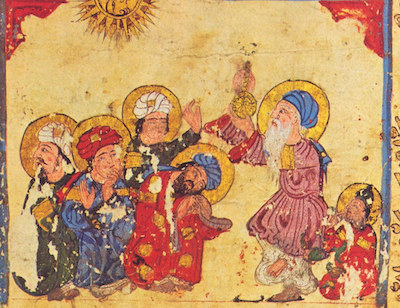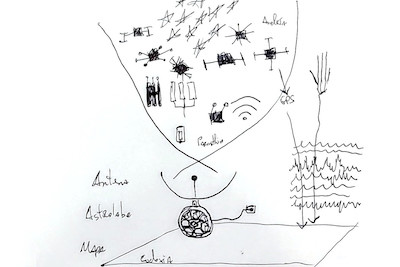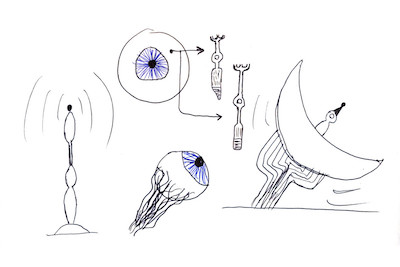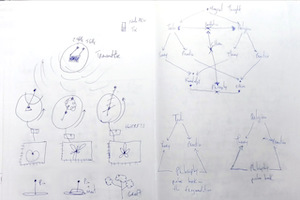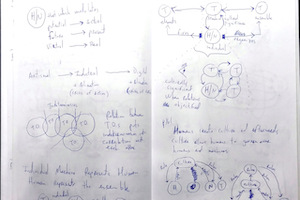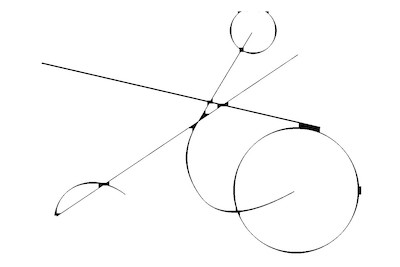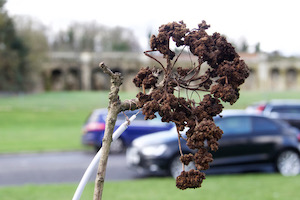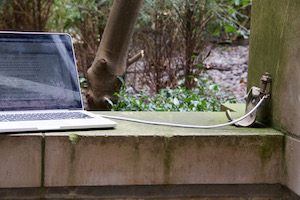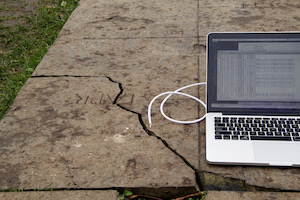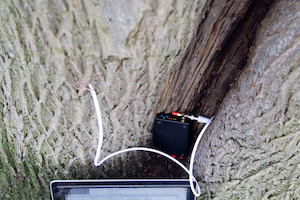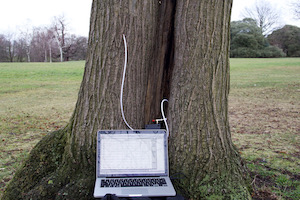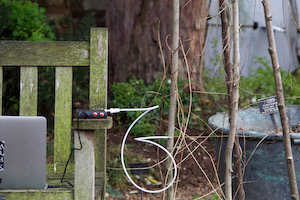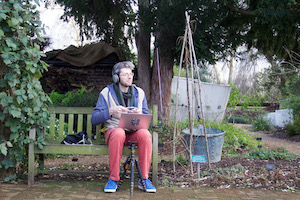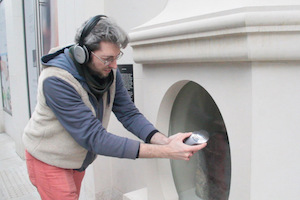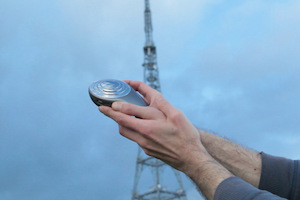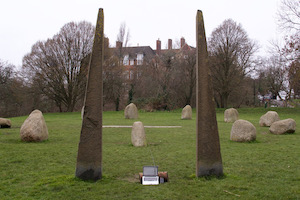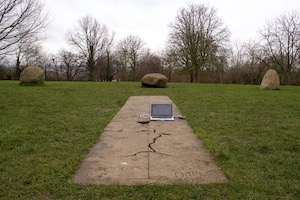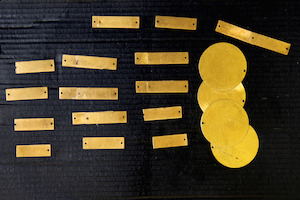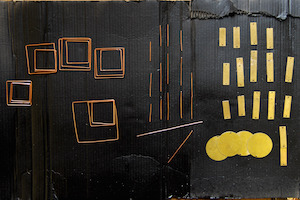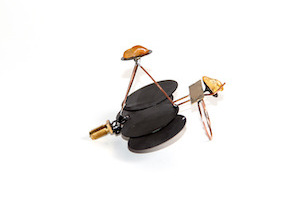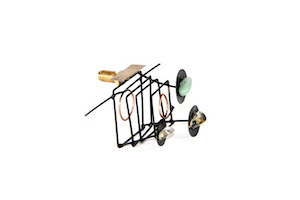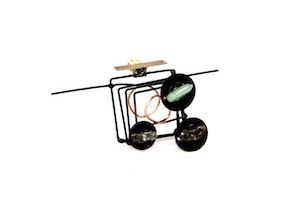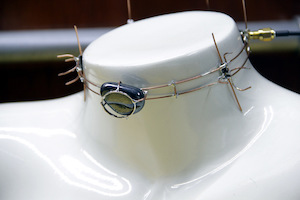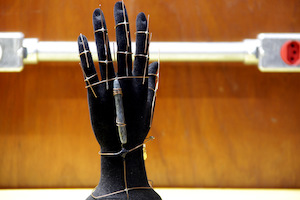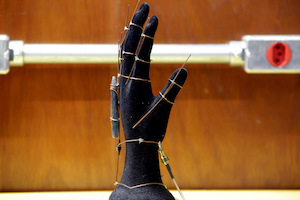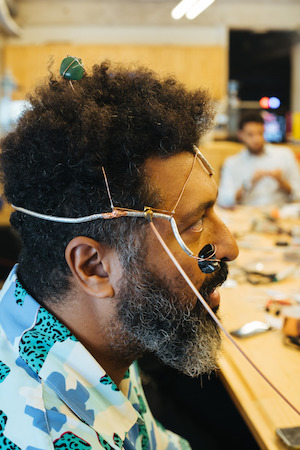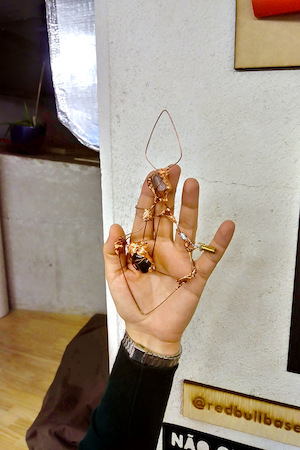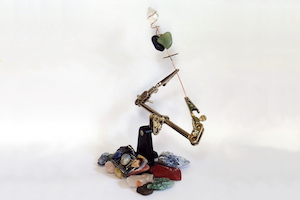Astrolabe
The starting point for this research was the astrolabe. An ancient instrument used by Islamic astronomers from around 550 AD, the astrolabe was made up of elaborate sliding metal discs and pointers, which were aligned to celestial bodies in order to give answers to astronomical, astrological and religious questions. Later on, this early measuring device had its moment in European history. It proved invaluable in helping to propagate and teach Islamic geometry during The Renaissance, and then, during the European age of empires, it was instrumental in maritime “discovery” expeditions.
Recognizing the astrolabe as a network technology that connected humans to a larger network of agents (stars), its function was that of a translator for some of the important questions of its time: harvest dates, prayer times, tidal cycles. The human, the astrolabe and the stars had to come up with answers by performing a ritual together.
In some ways the astrolabe foreshadowed today’s reality of smart objects and networked devices, combining the body, technology and environment, while being intricately intertwined with political systems and loci of power.
Materialities
As an unexpected result of our ingenuity, we've filled the skies with enough artificial satellites that it's not inconceivable to think that they could be read like stars by other machines. Their orbit and purpose initially dictated by human politics and desires, can now be reinterpreted as a kind of dynamic poetry for nonhuman communication -- electromagnetic lines in search of other Others.
Given the complex relationships that humans have today with both “natural” systems (as exemplified by global warming, oil extraction, etc), and engineered systems (internet as surveillance, container shipping routes), it feels imperative to avoid the anthropocentric error of always measuring these articulations against the arbitrariness of human linguistic signs and meanings. As Bruno Latour would say, we can’t keep pretending to be modern, holding on to ideals of pure histories, sciences, politics and technology, while at the same time creating these hybrid “monsters” (or cyborgs). Shouldn’t we at least consider alternative modes of representation and communication where the divisions between human and non-human agents and natural and political bodies become less clear?
Given the complex relationships that humans have today with both “natural” systems (as exemplified by global warming, oil extraction, etc), and engineered systems (internet as surveillance, container shipping routes), it feels imperative to avoid the anthropocentric error of always measuring these articulations against the arbitrariness of human linguistic signs and meanings. As Bruno Latour would say, we can’t keep pretending to be modern, holding on to ideals of pure histories, sciences, politics and technology, while at the same time creating these hybrid “monsters” (or cyborgs). Shouldn’t we at least consider alternative modes of representation and communication where the divisions between human and non-human agents and natural and political bodies become less clear?
Measuring
We can see that “technology” is never just about technology and in order not to be left out of these systems of knowledge and discourse that we create, we need to resensitise ourselves to these meshes of planetary reach and affect.
Feminist physicist Karen Barad has used insights from quantum physics to propose new materialities for objects, where measurements are agential practices and measuring devices “are not simply revelatory but performative: they help constitute and are a constitutive part of what is being measured”. One conclusion being that tools hold a special ontological place between matter and meaning, object and subject, nature and culture: tools are “world-making: matter and meaning do not pre-exist, but rather are co-constituted via intra-actions”.
This research looks into the complex networked relationships between humans, nonhumans and machines to find ways to sense data that makes no sense for humans, but whose interference can be felt: infrastructure, algorithmic left-overs, electromagnetic signals... We need ontological machines to explore and make explicit the complexities of these relationships, and create ways to make these interactions between humans, nature, culture, objects and networks a little more significantly felt.
Materially speaking, this research is about the sensitisation of objects and bodies and what makes them resonate. It also explores the possibility of language for revealing the desires, memories and inner conversations of objects and non-human phenomena. It’s an attempt to reach another kind of understanding about how they sense and shape their world, and, in turn, affect ours.
Feminist physicist Karen Barad has used insights from quantum physics to propose new materialities for objects, where measurements are agential practices and measuring devices “are not simply revelatory but performative: they help constitute and are a constitutive part of what is being measured”. One conclusion being that tools hold a special ontological place between matter and meaning, object and subject, nature and culture: tools are “world-making: matter and meaning do not pre-exist, but rather are co-constituted via intra-actions”.
This research looks into the complex networked relationships between humans, nonhumans and machines to find ways to sense data that makes no sense for humans, but whose interference can be felt: infrastructure, algorithmic left-overs, electromagnetic signals... We need ontological machines to explore and make explicit the complexities of these relationships, and create ways to make these interactions between humans, nature, culture, objects and networks a little more significantly felt.
Materially speaking, this research is about the sensitisation of objects and bodies and what makes them resonate. It also explores the possibility of language for revealing the desires, memories and inner conversations of objects and non-human phenomena. It’s an attempt to reach another kind of understanding about how they sense and shape their world, and, in turn, affect ours.
In addition to Karen Barad's intra-actions and Timothy Morton's hyperobjects, this project finds resonance in Bruno Latour's hybrid networks and systems, Donna Haraway and her Situated Knowledges, some of Italo Calvino's Invisible Cities, Shannon Mattern's deep media geology, Judith Butler's materialism, the ontological holy trinity of Human-Nature-Technology described by Gilbert Simondon, Michel Carrouges's célibataire machines, the proto-cyberfeminism of Shulamith Firestone, Xenofeminism from Laboria Cuboniks, the Interspecifics Collective and their ontological machines, (science-)fiction from Octavia Butler, METROPOLARITY, Joanna Russ and Monique Wittig, and the onto-anthropological questionings of Viveiros de Castro, Philippe Descola and Marshall Sahlins.
Amerindian Perspectivism
It refers to a synthesis of certain aspects of the cosmologies of Amerindian peoples, which have in common the belief that the world is populated by many species of human and non-human beings endowed with spirit, consciousness and culture. Each of these species sees itself as human, seeing all others as nonhuman, and are perceived by other species as animals, spirits, or nonhuman forms. Who or what sees a satellite as a human?
[1]
Andria
One of the invisible cities of Italo Calvino. This city was designed and built to be an exact reflection of the sky and its heavenly bodies. Changes in Andria correspond to changes in the cosmos, and vice versa. An invitation to think about the reach of human influence on the universe, and vice versa.
[1]
Astrolabe
Ancient instrument used by Islamic astronomers since 550 AD to measure time, locations and distances. Outside the Islamic world, this measuring device had its moment in European history: it was essential in the dissemination and teaching of Islamic geometry during the Renaissance, and later, during the age of empires, it was instrumental in maritime "discovery" expeditions.
[1]
Bachelor Machines
"Bachelor machines are fantastic images that transform love into a technique of death". They are mythic mechanical representations of the eroticism, desire, love, ecstasy, isolation and death materialized in early industrial societies. They are the negation of procreation and human genealogy, but, at the same time act as totems for the kinship of human beings with the mechanical, instead of with the animal or the vegetal.
[1]
Clarke Belt
Name given to the group of geostationary satellites orbiting the earth over the equator at a distance of about 36,000 km from the earth's surface. At this altitude the satellites rotate around the earth at the same speed that the earth rotates around itself, making each of them appear stationary from a terrestrial point of view. These satellites are generally used for communications and observation of specific regions.
[1]
[2]
[3]
[4]
Cyborg Manifesto
Cyborg is a metaphor used to think about our present condition of fragmented identities and socio-techno-political realities. As a result of the mixture of the biological and technological, the cyborg is a figure whose history is hybrid, multiple and transgressive by nature. Pointing to the far future, the manifesto predicted the impossibility of maintaining some of the fundamental divisions of Western thought implied in the dichotomies between nature/culture, body/mind, animal/human.
[1]
[2]
Deep Media Archaeology
Study of the extension, materiality and by-products of media and their infrastructures. It understands infrastructure as an infinite regression of relationships, which, despite its material elements, can never be reduced to a "thing" because it also includes conceptual objects such as measurement standards, classification systems, and technical protocols. Archeology provides a way to track how technology, architecture, economics, and other social practices are connected to media production.
[1]
[2]
[3]
Eudoxia
Another of the invisible cities. Eudoxia has a map in the shape of a carpet. It is not known which one of the two objects, city or carpet, follows the perfect order of the universe, and which one is just an approximation of the other. This city highlights some relevant connections and entanglements between city, map, universe and forms of representation.
[1]
Frequency Allocation
Process by which regulatory agencies divide the electromagnetic spectrum and distribute the use of frequencies between 3 kHz and 275 GHz to specific services. In Brazil ANATEL is the body responsible for authorizing, managing, regulating and distributing these frequency bands for commercial, public, military and educational uses. In the USA, the FCC and the Department of Commerce have similar responsibilities.
[1]
[2]
[3]
Hybrid Networks
Modern societies differentiate between nature and culture, whereas premodern societies do not make that distinction. Within these modern societies, a hybrid is something that combines aspects that would traditionally be considered separately in their respective natural and social domains. For example, in a scientific context what is called a natural phenomenon is actually an association that would not have been possible without the laboratory, the research program, and the specific way of describing it.
[1]
[2]
Hyperobjectss
Concept used to analyze the materiality and complexity of current "natural" systems (global warming, pre-salt oil reserves, ...) and "built" systems (internet as surveillance, Machine Learning, ...), which cannot be understood from a single ontological standpoint (social, economic, technological, cultural, philosophical, etc ...).
[1]
Intra-action
Proposed concept as an alternative / counterpoint to "interaction". Interaction requires pre-established subjects who then participate in actions with each other. Intra-action understands agency not as an inherent property of a subject, but as a dynamism of forces in which all bodies are constantly changing, influencing, and working inseparably.
[1]
[2]
Ley Lines
Supposed alignments of places of historical, political and/or geographical significance around the world. The idea that these points are connected by mystical/cosmic magnetic energy is controversial and based on pseudoscientific processes. Even so, it is still a reference for an imaginary, extensive, expanded and globalized cartography.
[1]
[2]
[3]
Ontological Machines
"Ontological Machines is a framework for the experimental artist, philosopher, scientist, human, organism or force to explore the entanglement of material experiences that together as a unity conform the complex expressions of reality; an interface whose existence is a temporary possibility of agency."
[1]
[2]
Performativity
Linguistic potential that is also an action (or becoming) with physical-materialistic consequences; Language is not just a way of describing, but a force that constructs. Gender, for example, is not just a category that describes a set of actions and behaviors, but rather the way in which these actions and behaviors are described and materialized as a result of an identity that is constantly redefined through discursive acts and symbolic communication.
[1]
[2]
[3]
Perinthia
Another of Italo Calvino's invisible cities. Perinthia was planned by astronomers who followed the placement of stars to dictate the construction of buildings, neighborhoods and borders. Aligned with eclipses and other celestial events, the city would mirror the harmony and reason of nature, but after a few generations the city found itself populated by "monsters". Latour's monsters and Haraway's cyborgs are also the result of mixing science, politics, nature and culture.
[1]
Situated Knowledges
It's impossible to depend on an objectivity where devices (technology, media, instrument used to measure something) or the person using a device is not considered part of the process that allows for results and measurements. The boundaries of any object of study materializes in social interactions and therefore are constantly shifting and being redefined. These boundaries are drawn by mapping practices; "objects" of study do not exist before that.
[1]
[2]
[3]
Stonehenge
Structure formed by stone circles, built between 3000 and 2000 BC in England. Despite much speculation about their true functionality, the placement of the stones correspond precisely to celestial events. In addition to signaling specific dates of celestial alignments (solstices and equinoxes), there is evidence that the structure could also have been used to predict eclipses.
[1]
[2]
[3]
Technique / Technology / Technicity / Techne
Technology and body are inextricably intertwined in a way that there is no natural, technologically untouched body. The relationship between technology and the body must be understood as a relationship of undetermined boundaries. Technologies are not mediations, are not things between bodies, but developments and connections, together with which exchanges between the living being and its environment happen.
[1]
[2]
Units of Measure
Xenofeminist Manifesto
Referencing that which is foreign, alien, excluded, and culturally "unnatural", xenofeminism is a proposal to reimagine feminism's emancipatory potential in times of automation, globalization, and digital revolutions. It proposes to destroy gender, dismantle the "family", prohibit the use of nature as a guarantor of unequitable political positions, and to denaturalize the disciplines of science, technology, and rationalism, rejecting the idea that they are inherently masculine or patriarchal.
[1]
[2]
[3]
Détournements
Measuring walks where readymade objects are used as antennas to investigate the electromagnetic environment.
Preliminary experiments done during a residency in January, 2019 at Delfina Foundation, London, UK.
Antenna bodies || Body antennas
The process of transmitting and receiving electromagnetic signals is very physical: matter moves in rhythms syncopated by the speed of light and the dimensions of the materials it traverses. Antennas are designed with specific shapes and sizes optimized for particular types of transmissions and their corresponding frequencies. For example, 2.4GHz WiFi signals are better picked up by antennas with lengths that are a multiple of 31.25mm.
In our world of embedded, pervasive, wearable technologies we are encompassed by such a variety of signals that we can think of this relationship from a different perspective: given different objects of specific shapes and sizes, what are the signals that reverberate with their bodies?
These wearable antennas are made of copper and brass pieces modeled after the shapes and sizes of body parts, sections, appendages, .... They are meant to be worn around the part of the body from which they were modeled, creating an additional connection between the original template body and that of the wearer.
Like the Astrolabe, these antennas suggest a more embodied form of navigating a network and exploring the relationships between humans, nature, culture and objects.
In our world of embedded, pervasive, wearable technologies we are encompassed by such a variety of signals that we can think of this relationship from a different perspective: given different objects of specific shapes and sizes, what are the signals that reverberate with their bodies?
These wearable antennas are made of copper and brass pieces modeled after the shapes and sizes of body parts, sections, appendages, .... They are meant to be worn around the part of the body from which they were modeled, creating an additional connection between the original template body and that of the wearer.
Like the Astrolabe, these antennas suggest a more embodied form of navigating a network and exploring the relationships between humans, nature, culture and objects.
Visualizing Worlds Collection™: designed collectively and collaboratively in September, 2019 during a workshop for the event "Visualizações de Mundos", curated by Cláudio Bueno in São Paulo, BR.
Algotypes
Algotypes is an intervention in the 2.4GHz WiFi band, inspired by the more esoteric sides of science that have been used to explain invisible phenomena.
Unlike æther or orgone, and despite pop-culture imagery associated with The Cloud, WiFi has a very material and tangible provenance. From minerals and metals to its radiant energy, there’s a very blunt aspect of this entanglement of culture and infrastructure that is physical and extends into surrounding bodies.
Here, these sculptures are equipped with WiFi transceivers and programmed to react to the signals floating around them. They capture packets of data from nearby routers and phones, which are then manipulated using classical computer science algorithms before being retransmitted on their own network.
Other than network names and some management packets, the pyramids can’t decode and deduce human meaning from this binary data, nor modify or block any communication. They only create their own interpretation of the raw bytes of information flying around. This would be the equivalent of cutting up copies of a book written in an unknown language and reorganizing the letters and words using different procedures.
Custom software displays information about the nearby WiFi networks: network names and channels, as well as a visualization of the packets being read and transmitted by the pyramids.
Unlike æther or orgone, and despite pop-culture imagery associated with The Cloud, WiFi has a very material and tangible provenance. From minerals and metals to its radiant energy, there’s a very blunt aspect of this entanglement of culture and infrastructure that is physical and extends into surrounding bodies.
Here, these sculptures are equipped with WiFi transceivers and programmed to react to the signals floating around them. They capture packets of data from nearby routers and phones, which are then manipulated using classical computer science algorithms before being retransmitted on their own network.
Other than network names and some management packets, the pyramids can’t decode and deduce human meaning from this binary data, nor modify or block any communication. They only create their own interpretation of the raw bytes of information flying around. This would be the equivalent of cutting up copies of a book written in an unknown language and reorganizing the letters and words using different procedures.
Custom software displays information about the nearby WiFi networks: network names and channels, as well as a visualization of the packets being read and transmitted by the pyramids.
Fragment d'histoire future (1896)
Gabriel de Tarde
Gabriel de Tarde
Short story about a future civilization that, due to climate change related to the sun's death, has to adapt to living within the Earth.
The Perpetual Motion Machine: The Story of an Invention (1910)
Paul Scheerbart
Paul Scheerbart
Short account of writer Paul Scheerbart's obsession with perpetual motion machines that would generate their own energy by redirecting the force of Earth's gravity. In addition to descriptions and diagrams, it also criticizes scientific and economic developmentalism, and includes philosophical and speculative considerations about the socio-political consequences of these machines. In the end he comes to the conclusion that such a machine would not be so advantageous for the environment or for the arts, and that the earth, the sun and the stars form the true perpetual motion machine; even in the great inventions that use electricity and steam the real work is still being done by the planet. Human being's obsession with work and development is an absurd competition with the planet, and peace and harmony are only possible through the recognition of this cosmic entanglement.
Totem and Taboo (1913)
Sigmund Freud
Sigmund Freud
Collection of essays about the possible origins of social customs and their relationship with neuroses. Pointing to social ambivalence as a source of neuroses and cultural formations, Freud understands one as the asocial way to obtain through private means, what in society arose through collective mediation. Interesting to think about in which ways culture is a form of neurosis.
Bertha, a menina-flor (1914)
Raymond Roussel
Raymond Roussel
Short surrealist story about the birth of a half-human half-flower girl.
Novas Descobertas de Adinolfa (1914)
Raymond Roussel
Raymond Roussel
Short story about the relationship between history, soul, ribs and wind.
Civilization and Its Discontents (1930)
Sigmund Freud
Sigmund Freud
Essay that explores tensions between the individual and social spheres of development and desire, briefly touching on the theme of the relationship between human happiness and nature/culture/civilization.
Not entirely dialectic account of the interplay between different functions of the organism. Uses the orgasm to explore the "fuzzy boundaries" between psychological, physiological and sociological aspects of biological life. Specifically, the functional connection between mechanics and electricity and their role in biological activity. In the process, Reich fuzzies other boundaries by proposing that a contractile vegetative nervous system, an uniform network of plasma, common to all living things, phylogenetically predates the cerebellum and is responsible for certain affects like anxiety, rage, fright, pleasure in multi- and unicelular organisms. Everything contracts/expands at different levels: neurons, fluids, vegetative nervous system, organs, organisms, psyche, society. This is "the animal in man" and "the devil in the flesh".
Practical-theoretical formulation of the function of the orgasm and its psycho-socio-political consequences. Proposes a total inversion of concepts established by psychoanalysis at the time in relation to the roles of culture and nature, instinct and compulsion, and the relationship between biological/somatic and psychological processes. It also presents theories about mass psychology and fascism.
Les Machines Célibataires (1954)
Michel Carrouges
Michel Carrouges
Dioptric study of various configurations of bachelor machines in literature, but starting with Duchamp's "Large Glass". It expounds on the characteristics of this modern myth, which mixes bodies, machines, and nature into dynamics of desire, love, death, ecstasy, eroticism, isolation and power. In a simplified sense, bachelor machines create "images that transform love into a technique of death" in the intersecting space between humans and machines, anthropology and mechanics.
Du Mode d'existence des objets techniques (1958)
Gilbert Simondon
Gilbert Simondon
Formal treatise on the genesis of technical thinking, and its ramifications in aesthetic, philosophical, political, and moral thinking.
Deux leçons sur l'animal et l'homme (1963)
Gilbert Simondon
Gilbert Simondon
Notes from lectures that present in chronological order philosophies and schools of thought concerned with the difference between human, animal and vegetable. It is a summary of the history of Western thinking about human identity based on the Human/Animal and Human/Nature dichotomies.
The Dialectic of Sex (1970)
Shulamith Firestone
Shulamith Firestone
Study of the role of the male/female division on the horizontal and vertical relationships between sexual, racial, economical and cultural dialectics. Includes an analysis of how the existence of an underlying dialectic of sex molds the history of culture. Shows how modern science has been determined and corrupted by this sex duality. Culture is the sum and dynamics between the idealistic and scientific modes of thought, and both sides are attempts to transcend the limitations of reality. This division between the aesthetic/subjective/intuitive/id and technological/objective/logical/ego recreates the sexual and psychological divisions, and contributes to the creation of its superstructure, the economic system. It has become necessary to free humanity from the tyranny of its biology.
Why Look at Animals? (1977)
John Berger
John Berger
Essay on the development of the relationship between humans and animals between the 19th and 20th centuries, and the political, social and affective implications of these transformations.
Dawn (Xenogenesis #1) (1987)
Octavia E. Butler
Octavia E. Butler
Science fiction story that describes the relationship of humans with other natures and non-binary beings. It focuses on relationships between species that communicate through language, but also through more integral, material and bodily interactions between different kinds of sentient beings and materials.
Les trois écologies (1989)
Félix Guattari
Félix Guattari
Essay that proposes a redefinition of ecology to encompass social relations and human subjectivity, as well as environmental concerns. It argues that a new eco-philosophical approach that respects the differences between all living systems (social, political, economic systems) is necessary to deal with current environmental problems.
The Orgone Accumulator Handbook (1989)
James DeMeo
James DeMeo
Summary of the discovery, use and benefits of Reich's energy. It contains plans for building different types of orgone accumulators, suggestions for its uses and notes on the necessary precautions to prevent toxic energies and destructive orgone.
Collection of essays on: (1) Social and political bias in primate research, (2) Language and politics in primate and biology research, and (3) Politics, (cyber-)feminisms, discourse, situated knowledge and other sciences.
Nous n'avons jamais été modernes (1991)
Bruno Latour
Bruno Latour
Questions certain divisions of knowledge starting from Boyle and Hobbes' disagreemnts in the 17th century. Criticism of the idea of modernity based on paradoxical suppression and proliferation of hybrid objects and knowledge systems.
A Inconstância da Alma Selvagem (2000)
Eduardo Viveiros de Castro
Eduardo Viveiros de Castro
Essays and articles on different ways of seeing, understanding and organizing the world, according to Amerindian cosmologies.
Manifiesto Contra-sexual (2000)
Paul B. Preciado
Paul B. Preciado
Manifesto that proposes the recognition of body parts as technology. A proposal to imagine the plasticities of bodies as a potential overcoming of nature. Provocation for a history of sexuality where artifice (object and skill) precedes Nature.
La philosophie de Simondon (2003)
Pascal Chabot
Pascal Chabot
Summary of the best of Simondon's philosophies.
Reflections on the relationship between dogs, humans, history, science, politics, technology.
Neo-liberal Genetics (2006)
Susan McKinnon
Susan McKinnon
Anthropological criticism of evolutionary psychology theories from Pinker, Buss, etc. It shows how the scientific beliefs of this theory that aims to explain all human behavior based on genetics, in fact only serve to reinforce socio-political principles and behaviors coming from a specifically Victorian and neo-liberal culture. It presents numerous examples of cultural variations between peoples throughout history to show that, contrary to the proposals of evolutionary psychology, the development of cultures has a complex relationship with the biology of genes in the process of evolution.
Ecology without Nature (2007)
Timothy Morton
Timothy Morton
Mixture of criticism and theory on aesthetics, ecology and art starting from 19th century Romantic literature. Although a bit convoluted, a kind of call to rethink the ways in which art represents nature and the environment. The monolithic romantic thinking of "nature" no longer works; we need more accurate, weird and messy poetics that reflect our current ecological/environmental situation.
L'économie, science des intérêts passionnés: Introduction à l'anthropologie économique de Gabriel Tarde (2008)
Bruno Latour & Vincent Antonin Upinay
Bruno Latour & Vincent Antonin Upinay
Short introduction to sociology of Gabriel Tarde. A sociology that, critiquing nineteenth-century theories about economics and political economy, reinterprets the theory of evolution, notions of natural/artificial, and systems of associations and connections between humans.
The Western Illusion of Human Nature (2008)
Marshall Sahlins
Marshall Sahlins
Essay about the evolution of economic and political theories based on the naturalization of philosophical, scientific and cultural concepts. For example, over the seventeenth and nineteenth centuries individualism and self-interest became the characteristics of the human being needed to form societies, rather than the defects that needed correction by society. Many non-Western cultures cut through or bypass these logics with distinct systems of kinship and affinities.
Drive Your Plow Over the Bones of the Dead (2009)
Olga Tokarczuk
Olga Tokarczuk
Novel about a possible revenge from Nature.
Ontology of the Accident (2009)
Catherine Malabou
Catherine Malabou
Essay about the concept of destructive plasticity from a psychological take on traumatic events, accidents, aging, etc. The ontology of the accident comes with events that create an "existential bifurcation... whose present does not come from any past, whose future has no future". But at the same time this other is not necessarily another and is always present. It also makes connections between neuroplasticity and Freud's concepts of plasticity and elasticity.
L'écologie des autres (2010)
Philippe Descola
Philippe Descola
Summary of various strands of anthropology that created divisions between Nature and Culture, and some new perspectives, discussions and problematization about this division.
Para além do princípio antrópico: por uma filosofia do Outside (2012)
Fabián Ludueña Romandini
Fabián Ludueña Romandini
An essay tracing the origins of anthropocentrism in philosophy and science starting from the Cabirian Mysteries, as described by Schelling. After a brief discussion of the functionality of the concepts of metamorphosis, life/Dasein and death in philosophy, it proposes a post-anthropic ontology in the sense of thinking about existence beyond any kind of life, not just human life. Briefly raises "the possibility of a lifeless topography ... or at least one where life is not the supreme purpose of all nature."
What Animals Teach Us about Politics (2014)
Brian Massumi
Brian Massumi
Proposes that it is possible to create a political understanding of our actions and interactions with other bodies through acts of play (fighting, hunting). From these becomings we can derive a "logic" about animal instinct, behavior, thought, and language that also includes the human. And within this animal continuum there is no privileged species.
Aesop's Anthropology: A Multispecies Approach (2014)
John Hartigan Jr.
John Hartigan Jr.
Proposal for new anthropologies that take into consideration the culture of non-human beings. It shows how much of human culture is guided by metaphors and allegories, but also "natural" (non-human) processes and becomings. For example, the role of concepts such as native, climate, diversity and even culture, which come from biology and then appear in discourses that attempt to naturalize racism, sexism and other human behaviors, goes beyond symbolic/linguistic realms to operate on material and procedural registers. Humans learned culture from nature. If domestication + cultivation + plasticity + gene expression = culture, other species are not only "cultured" but were necessary for the creation of human culture.
The Xenofeminist Manifesto: A Politics for Alienation (2015)
Laboria Cuboniks
Laboria Cuboniks
Accelerationist manifesto about the limits of concepts like Culture, Science and Nature as used today, and strategies for overcoming and re-capturing these terms and concepts. "In the name of feminism, 'Nature' shall no longer be a refuge of injustice, or a basis for any political justification whatsoever! If nature is unjust, change nature."
Suture (2015)
Morten Søndergaard
Morten Søndergaard
Post-language poetry; book of continuous transcript of suture lines from 100 skulls.
Deep Mapping the Media City (2015)
Shannon Mattern
Shannon Mattern
Study of the extension, materiality and by-products of media and their infrastructures. Looks at infrastructure as an infinite regression of relationships, which, despite its material elements, can never be reduced to a "thing" because it also includes conceptual objects such as measurement standards, classification systems, and technical protocols.
Animais Quase sábios, animais quase loucos (2016)
Mario Perniola
Mario Perniola
Short essay on different forms of animal instinct, intelligence and feelings, and how they unfold in creating a hierarchy between humans, animals, fools and sages.
How Noise Matters to Finance (2016)
N. Adriana Knouf
N. Adriana Knouf
Study on the role of "noise" in stock market profit maximization techniques. Brief history of stock market digitalization and the transformation of the human noise from stock sales to the machinic noise of algorithms. Proposal for noise as an accelerationist tool of symbiosis between human/culture/machines.
A Virada Vegetal (2018)
Emanuele Coccia
Emanuele Coccia
Short essay on the vegetable perspective of becoming. From the idea of seminal reason of seeds, it creates a theory of agency based on the perpetual relationships and movements between matter and form, creation and action, reproduction and growth.
O Universo Inacabado (2018)
Mario Novello
Mario Novello
Book on new developments in physics and the proposal of cosmology as a possibility for the refoundation of all sciences. It argues that the idea that it's possible to extend the laws of "nature" that work on earth to every corner of the universe is a new version of the geocentrism from past centuries.
A Billion Black Anthropocenes or None (2018)
Kathryn Yusoff
Kathryn Yusoff
Social criticism of the concept of anthropocene. Study of the role of geology and extractivism in the production, promotion and justification of racist practices, logics and discourses. Analysis of the power relations that materialized entire economies during the historical moments that are considered as possible points of origin for the anthropocene (1452, 1610, 1800, 1950).
Paradise Rot: A Novel (2018)
Jenny Hval
Jenny Hval
Exploration of human/vegetal sexuality, desire, decay, transformation and transmutation.
The A-Z of Gravity's End: Your Ultimate Guide to Free Fall and Levitation (2019)
Bjørn Hegardt and Theo Ågren
Bjørn Hegardt and Theo Ågren
Glossary of terms related to gravity and its consequences. Poetic, artistic, cultural exploration of the dialectic between falling and levitating; and how creativity adn fantasy play into science and knowledge.
